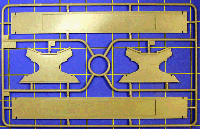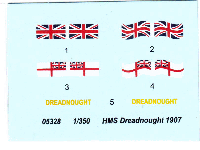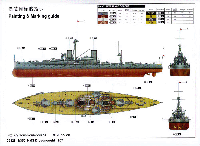| HISTORY |
|
|
HMS Dreadnought- the ship whose name became a byword for all future battleships. The launching of Dreadnought spelled a true paradigm shift in the naescent naval arms race, and splintered the steam and steel age into "pre-dreadnoughts" and "dreadnoughts": and made the other navies of the world consider their existing capitol ships obsolete. Dreadnought accomplished this with two important "firsts";
- First capitol ship will an "all big gun", or uniform caliber, main battery (12" Mark X gun x10)
- First capitol ship powered by steam turbines
This gave Dreadnought an unparalled broadside, and made her faster than any other battleship afloat. This design, with minor changes, continued through the next two class of dreadnought battleships built by the Royal Navy. In the end, HMS Dreadnought had a relatively uneventful career, and never engaged in the primary purpose to which she was designed- gunnery duels with other battleships.
(If you are interested in the design history of Dreadnought and the influence on the balance of power in Europe she had, I highly recommend Dreadnought by Robert K. Massie.)
|
| HULL AND DECK |
|
|
Dreadnought, as modeled by Trumpeter, is in a two-piece full hull configuration, side-by-side, with internal bulkheads for stiffening. This method appears to be a growing trend with plastic model ship manufacturers. The hull halves for Dreadnought are almost indentical, with only the number of hawse holes (two to starboard, one on the port) differentiating them. The hull has some raised hull plating lines on the upper hull sections, with square ports and scuttles (portholes) with eyebrows (also called rigols). There are also regularly spaced mounts for the torpedo net booms and anchor points for the boat booms also molded on the hull; however the torpedo net shelf isn't apparent. The external armor plate for the wing mounted turret barbettes is also molded integral to the upper hull works.
Below the waterline there are two openings for the broadside torpedo tubes on each side; sadly, Trumpeter appears to have missed the fifth and final submerged torpedo tube which should be in the stern. The bilge keels have been molded separately, which allows a more scale appearance- there is an outline etched into the lower hull to aid in placement. Likewise, there are similar etched ovals for the shafts, shaft bearings and skegs.
Hull appears about 1mm short at waterline- but this is well within measuring tolerance- call it "to scale." The surface of the hull halves is nicely devoid of the grease and raised mold lines seen for years on Trumpeter kits.
|
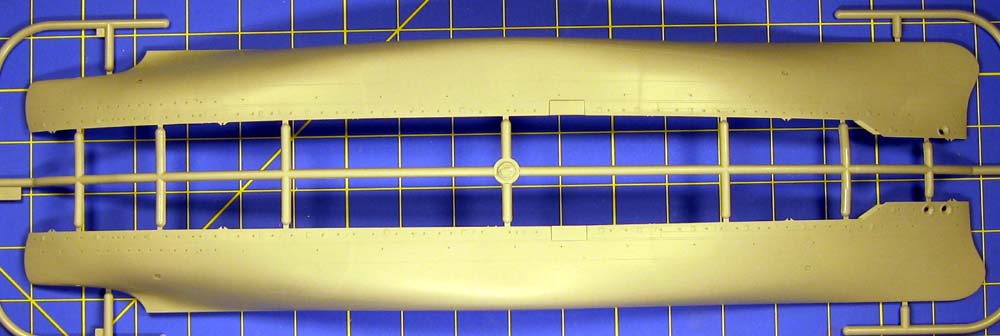 |
|
|
|
The one piece deck has regular deck planking and many of Dreadnought's hatches, vents and skylights have the basic shapes molded on, with a reinforced outline to aid positive placement of the superstructure. There are also a series of round hollows, where the photoetched coal scuttles and escape hatches will be placed. The "X" turret barbette has a large sprue remnant which will require removal.
|
 |
|
|
| SPRUE L (Flying Deck) |
|
This part is labled sprue "L", but is consists of a single "flying deck." This is the primary superstructure part, running from the fo'c'sle to amidships. It was wrapped in protective foam in two places, with the foam having been sealed with a newer, wider clear tape. Unfortunately, this wider tape allowed the foam to be drawn too tightly around this deck part, damaging some of the fine detail. This is doubly unfortunate, as some of the deck bulkheads are the thinnest Trumpeter has ever molded, and the places which are deformed are where the 12-pdr pedestal guns will be placed.
The deck has the same regular planking see on the main deck, as well as the skylights and vents. The superstructure bulkheads have scuttles, vents and hatches- these appear correctly spaced. The "A" turret barbette features the styrene remnant as the "Y" barbette on the main deck.
|
 |
|
|
| SPRUE A |
|
Sprue A has both the 45' and 50' steam pinnace's, as well as the sailing launch and sailing pinnace, and the racks for the boat deck which support them. This sprue also features the parts to make the two funnels, the breakwater, and the parts for the conning towers. The upper/boat deck pieces, "A3" and "A20" will need numerous holes drilled/opened up before attaching to the flying deck.
|
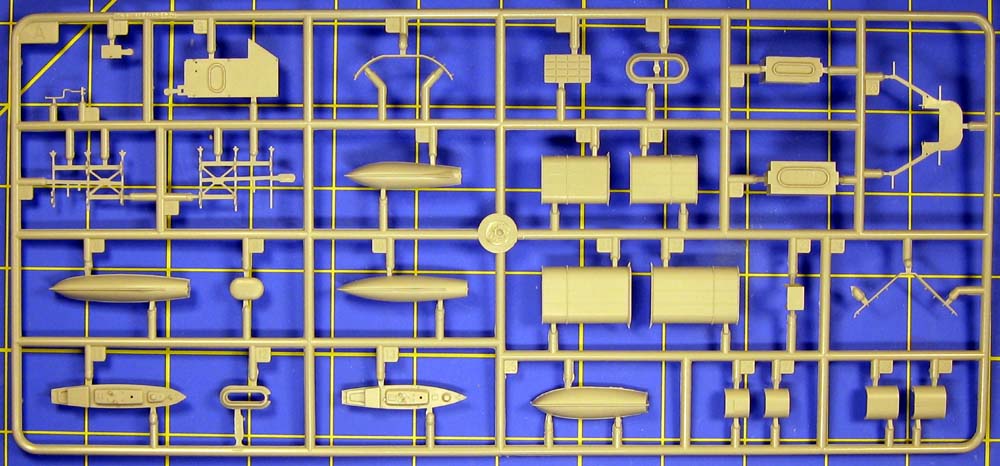 |
|
|
| SPRUE B |
|
B has the bilge keels, the shafts with skegs and the shaft bearings with struts. Some anchors are also hear, along with booms, catheads, and some various external details.
|
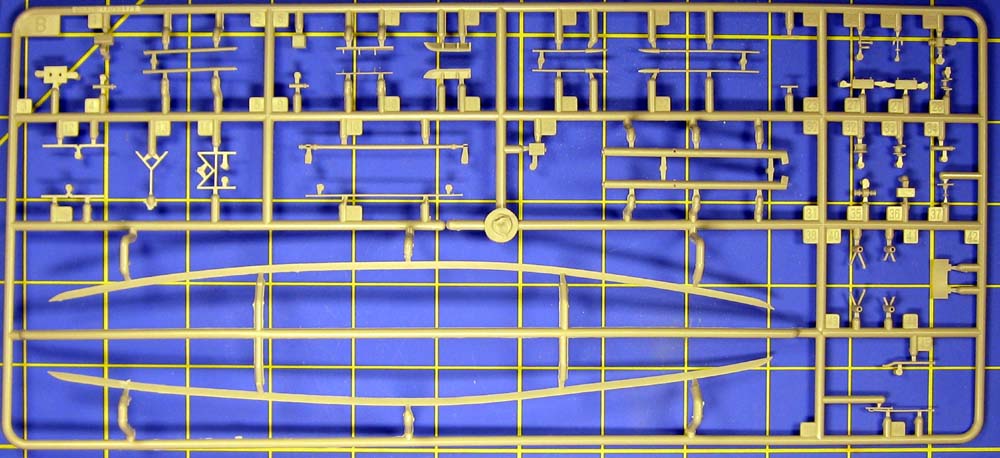 |
|
|
| SPRUE C |
|
Sprue C the bulkheads for reinforcing the main hull halves, and the large foremast/yard assembly for the foretop. This part has some attendant flash and awkward attachment point, so take care when removing from the sprue. This part may be prone to breakage or sanding out of round. C also has a small deckhouse and some additional deck gear (winches, reels, pipes, booms, etc.)
|
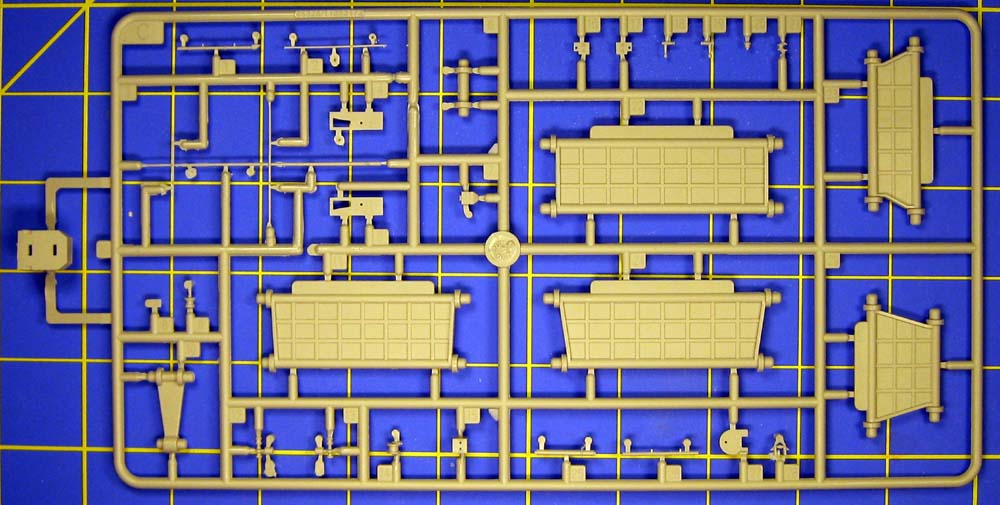 |
|
|
| SPRUE D x2 |
|
This sprue has Dreadnought's weapons; the 12" Mark X guns and turrets and the 12-pdr anti-torpedo boat guns, as well as a host of other parts; rudders, screws, searchlights, cutters and even more deck gear.
The turrets appear to have a good shape, with the three viewing hoods separate multi-part photoetch assemblies. The 12" barrels are slide-molded, with open muzzle crowns.
The 12-pdr guns are all identical, molded with the pedestal mounts as one piece.
The rudder has a good shape, and the screws have the correct number of blades.
|
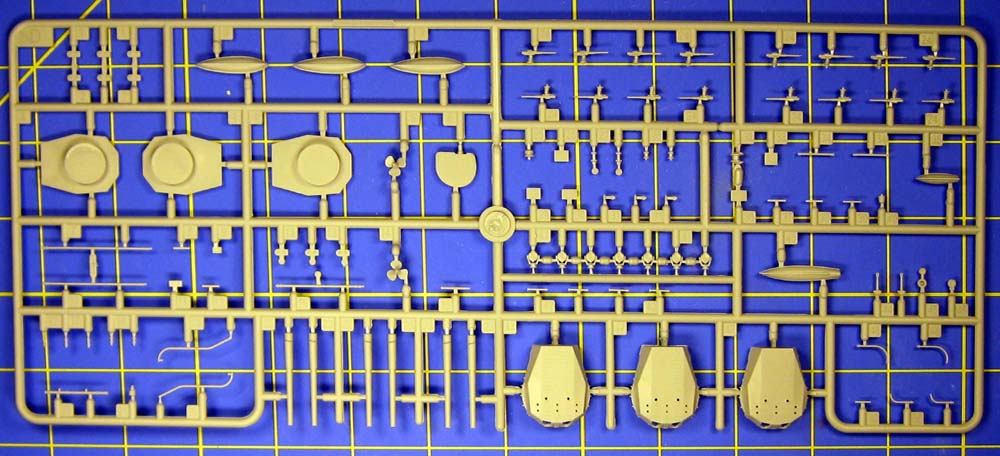 |
|
|
| SPRUE E |
|
This half-sized sprue has a few more parts for the bridge and fighting tops and the included nameplate is attached here. However, the main focus of this sprue are the torpedo net booms. Dreadnought carried 13 on each side; 12 30' booms and a single 12' boom forward. All are on E, and most have three attachment points to the primary sprue- and look quite fragile.
|
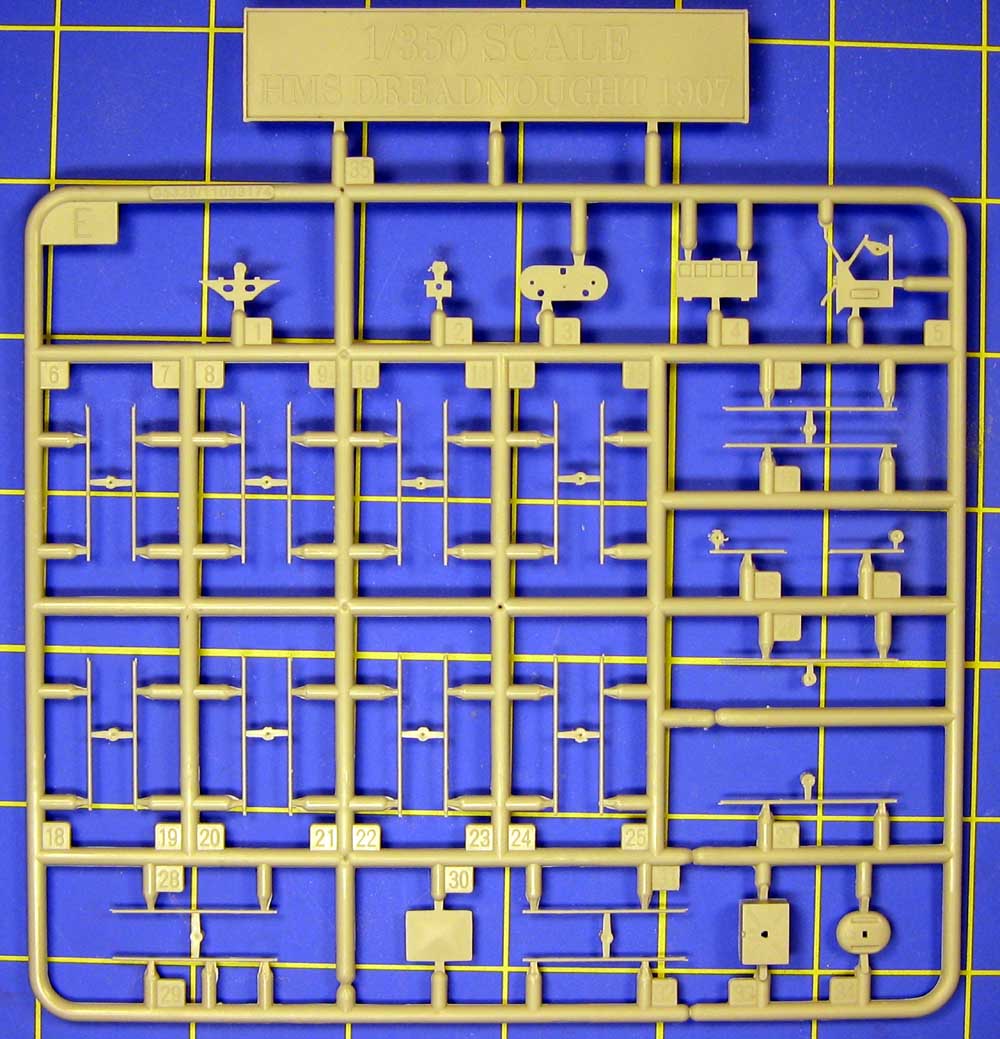 |
|
|
| SPRUE F |
|
This sprue has the platforms for the bridge and main superstructure area, as the mast/yard combo for the mainmast, and another deckhouse. The platfoms have the same planking detail seen on the decks, but the bulkheads are slightly thicker than on the flying deck.
|
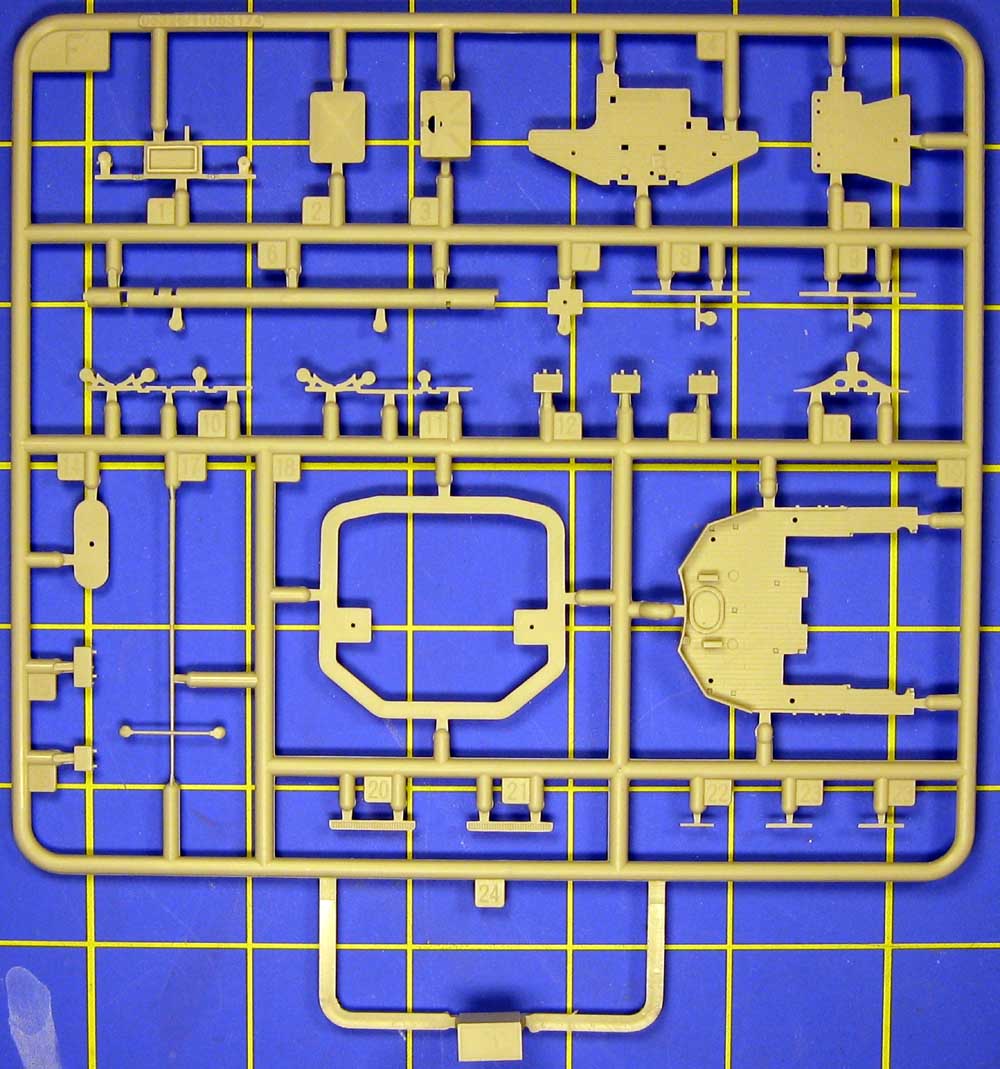 |
|
|
| SPRUE J |
|
The final sprue for Dreadnought has the bridge and radio shack deckhouse, and the remaining ship's boats.
|
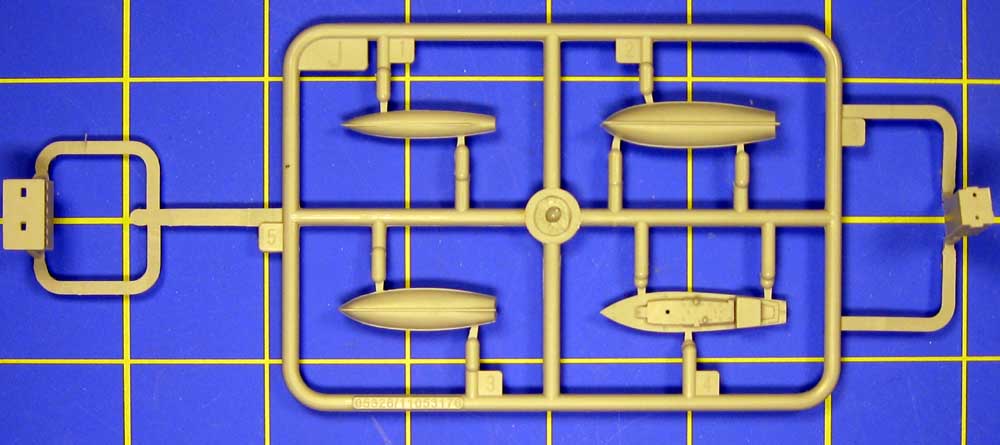 |
|
|
| PHOTOETCH |
|
Dreadnought includes three frets of photoetch. Trumpeter has been expanding the including photoetch with its kits, to the point to where some parts are only available as etch, with no plastic equivalent.
These frets include the expected parts- railings, ladders and stairs, along with angled supports for platforms. They also include the large number of round coal scuttles for the main deck and the parts to make the vision blocks for the main turrets. The also include the gun port doors for the 12-pdr's, although most of these were removed in early 1907.
|
| Fret A |
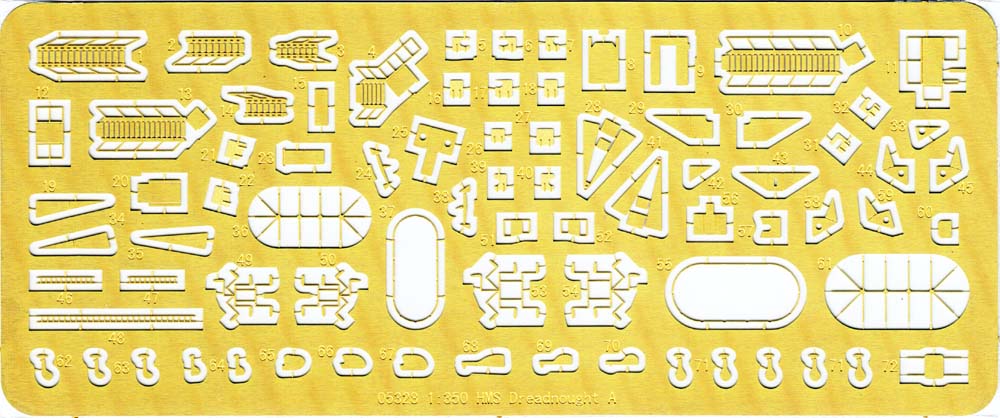 |
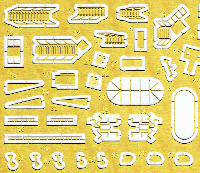 |
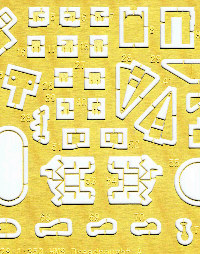 |
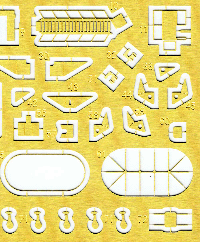 |
| Fret B |
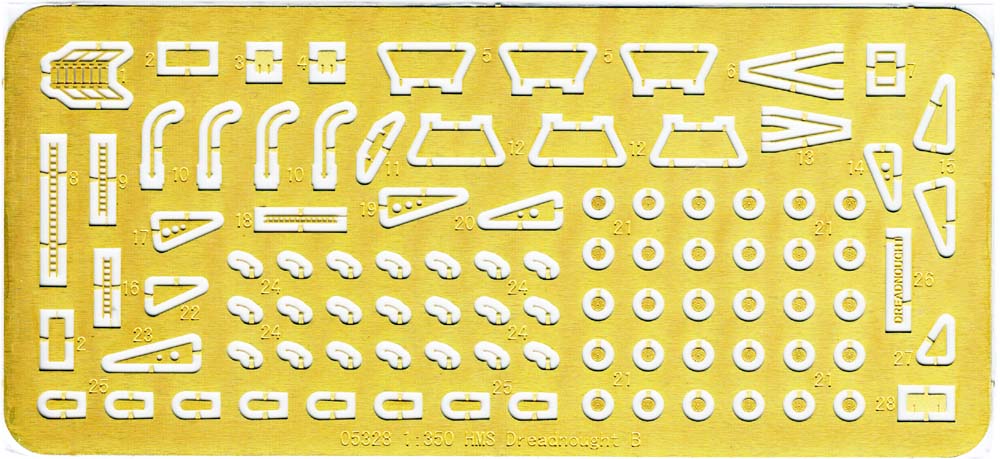 |
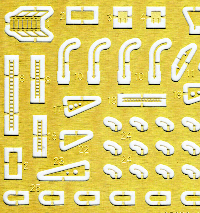 |
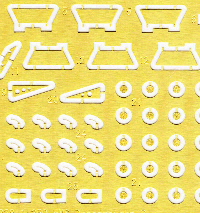 |
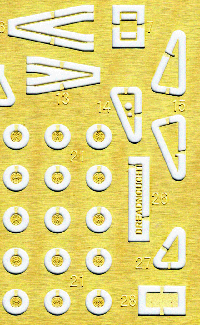 |
| Fret C and Chain |
 |
 |
|


